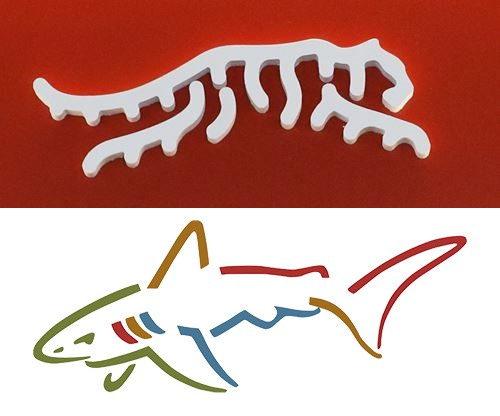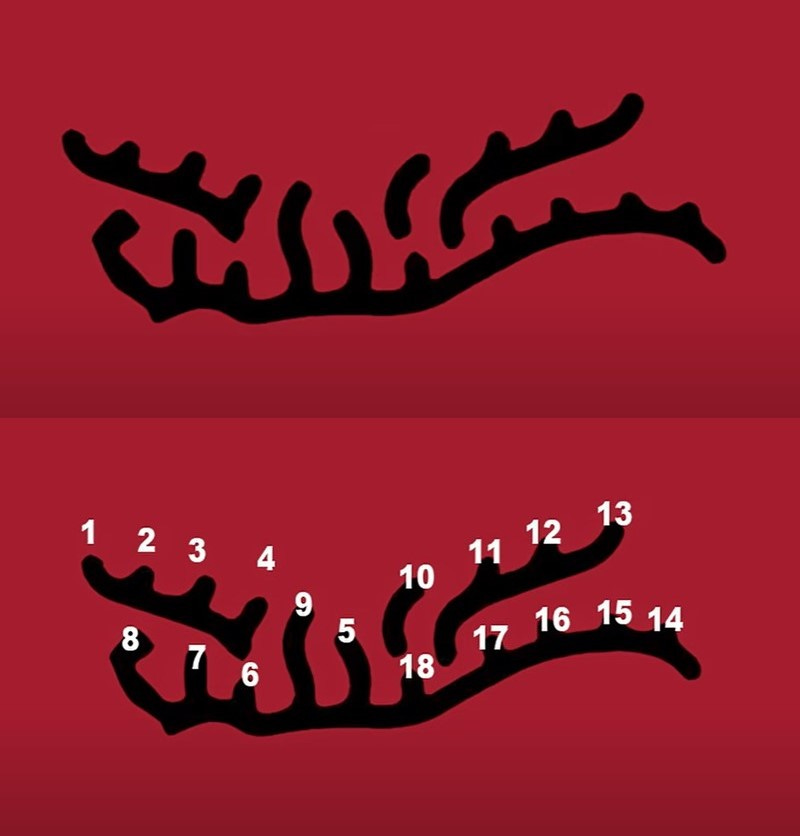Tiger’s new Sun Day Red venture and garbage at the Waste Management Open
Tiger Woods and TaylorMade join forces for an ambitious new apparel venture, and does anyone care about the attention fan behavior is getting at the WM Open?
This is a little experiment at The Wedge. On top of the longform essays, which I’ll continue to publish once or twice a month, I’ll be offering a weekly wrap every Tuesday on the stories that have been catching the eye from money and business in the great game of golf.
This week:
Tiger’s new brand and why it might be a perfect combination
The WM Open’s “Coliseum”
Thank you for being here. The Wedge is a reader-supported publication. If you enjoy these articles and would like to support independent media focused on the business, money and mystique of the world’s greatest game, please consider a monthly or annual subscription or gift a subscription to someone who might value this content.
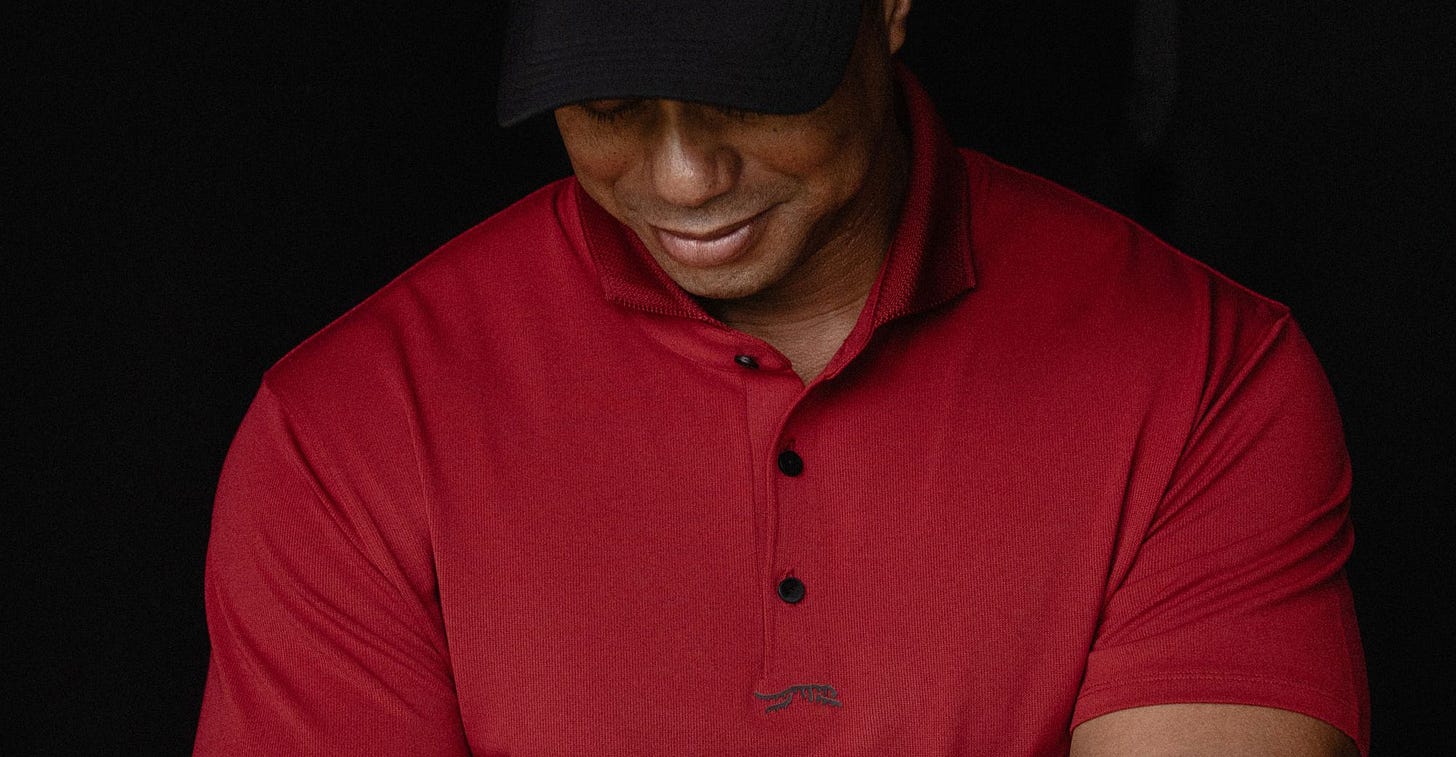
1. Tiger & TaylorMade: a match made in heaven?
Tiger Woods teased a new apparel venture last month in announcing the end of his 27-year partnership with Nike, and his brand new, er, brand was revealed amid light, cameras and action at a media event in Los Angeles on Monday.
Sun Day Red — more on the thinking behind that precise name shortly — is a venture in partnership with TaylorMade, with whom Tiger has had an equipment deal since Nike stopping making his clubs a number of years back.
Reaction to the new brand on social media was — this is social media, after all — decidedly mixed.
The logo, a stylised leaping Tiger, came in for some harsh criticism.
Others questioned the wisdom of the entire venture, expressing skepticism of whether Tiger ever had the power to move apparel, never mind whether he does so now in the twilight of his playing days, suggesting Nike’s exit was directly related to the ineffectiveness of Tiger to influence golf fan purchases.
Business decisions are much more complex than all that, though. To say “Nike couldn’t sell gear, ergo Tiger is no good at shifting gear” is throwing everything in a pot and boiling it down til you have a lowest common denominator that tastes like a nothingburger.
Nike’s partnerships with Woods and, latterly, Rory McIlroy are golf’s most high-profile endorsements, but the reality is that the two key entities here — golf in general and the Nike-golf relationship in particular — remain peripheral in the broader sports and business landscape.
“Golf clothing was just too small a piece of the Nike pie to merit a whole lot of consideration.”
For all its growth and appeal in recent years — especially during Covid lockdowns, when men everywhere (also women, but … mostly men) were driven so stir-crazy by 24 hours a day in their new home/office that the fairways took on a bright new allure — golf remains a niche sport that trends towards older, more affluent, more conservative demographics.
And it’s that conservatism (mentioned here vis-a-vis life decisions rather than party politics) that meant Nike was always a golf industry outsider, almost irrespective of how much money it might rake in around the world.
Nike might leave Titleist, Callaway, Ping, FootJoy and TaylorMade in the dust when it comes to revenue…
… but the reality is that Titleist, Callaway, Ping, FootJoy and TaylorMade all had, and have, more powerful golf brands than Nike.
For context, the global golf apparel market was valued in one estimate at more than $4.3 billion by 2022, with data from a couple of years earlier pointing to a Nike market share of 4.75%.
Extrapolating from those two figures gives us a rough estimate of the value of Nike’s apparel business of approximately $204 million, give or take a wide margin of error of, say, $20-30 million either way.
Those sums are not nothing, of course, but in the greater scheme of things — i.e. keeping in mind total annual revenues of more than $50 billion — golf clothing was just too small a piece of the Nike pie to merit a whole lot of consideration.
So like a long marriage that has finally run its course, both Tiger and Nike were probably ready for something new.
Which brings us back to Sun Day Red.
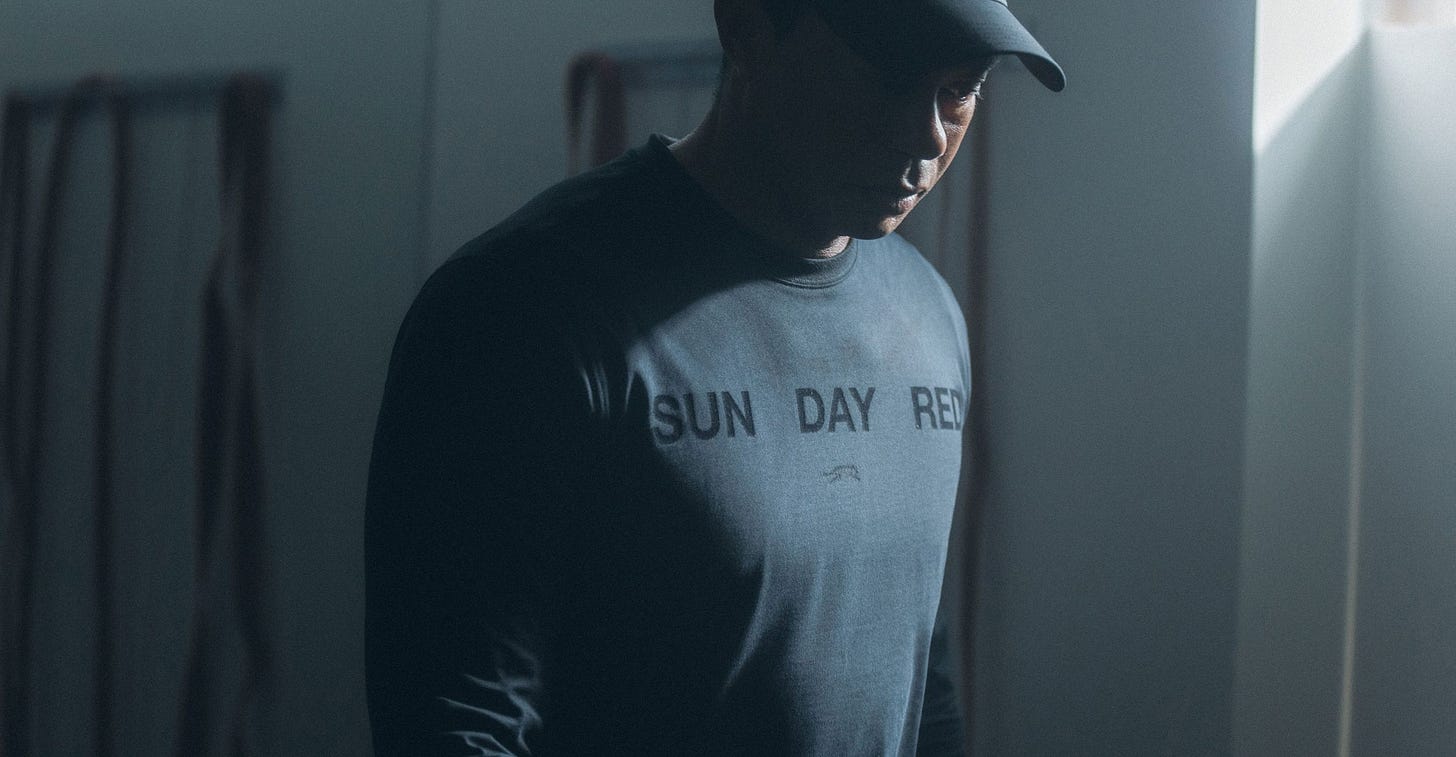
The two big things the new brand has going for it are:
Tiger
TaylorMade
First, Tiger
In a strange way, his passage into the twilight of an obscenely successful career may well leave Woods in a better position to maximize a brand like this now than in the height of his playing days.
Back then, Tiger’s focus was on winning on the course.
Whatever big-money endorsements came his way and fit snugly with his brand, well, they would always be considered.
But Sun Day Red feels like something that’s potentially orders of magnitude more substantial than just another celebrity endorsement or name-led brand.
And reading the press release and web copy, it seems that Tiger has been much more hands-on with this new brand than he might have been with Nike or any other clothing products he was involved with in the past.
With my emphasis:
Sun Day Red [is] a brand that promises to bring a new and elevated standard to performance wear and luxury lifestyle fashion.
Each piece incorporates [Tiger’s] specific requests, from enhanced shoulder seaming that promotes full motion, unrestricted swings, to 2-way zippers and pocket seaming that eliminate bulking, plus collars and cuffs precisely designed and measured for optimum performance.
Tiger said:
“I have learned so much over the years and have a lifetime of experience adjusting my apparel and footwear to help me play better based on the way it was constructed. There are things that I could tell you that no one knew I was doing over the years. I'm ready to share those secrets with the world.
Second, TaylorMade
Of the iconic golf brands mentioned above, TaylorMade is the second youngest: it was founded in 1979 by Gary Adams in Illinois, compared with 1923 (FootJoy, as part of the Field and Flint Company), 1932 for Titleist (Phillip E. Young), 1959 for Ping (Karsten Solheim) and 1982 for Callaway (Ely Callaway Jr).
With golf brands, decades are important.
In the mid-pandemic mergers and acquisitions frenzy, the most headlines were generated by Callaway’s purchase of TopGolf, but not far behind it in terms of cash value was the acquisition of TaylorMade by Korea-based private equity firm Centroid Investment partners for a reported $1.7 billion.
With golf brands, money is important too.
This combination in Sun Day Red — the once-a-century allure of Tiger Woods, the decades-old knack and know-how of TaylorMade and the global focus of the business’s investment industry owners — could be a partnership made in heaven.
David Abeles, the TaylorMade CEO, clearly thinks so, revealing that while TaylorMade are behind it, the brand will stand alone.
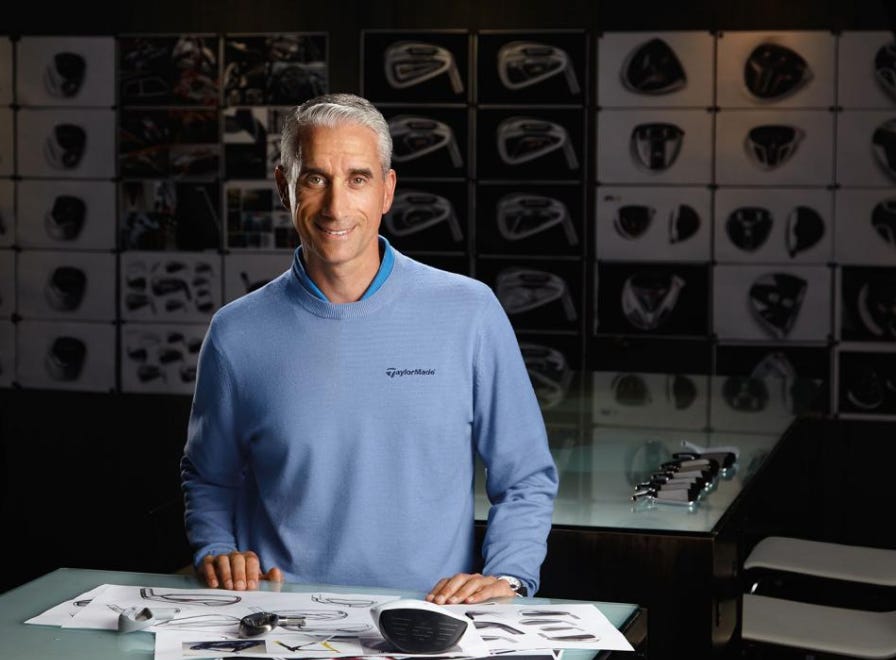
He said:
“[Sun Day Red] is independent from TaylorMade and it is run by an independent group of leaders that are part of my team — I couldn’t be more thrilled — so that we can focus on what matters on this brand most.
“This brand will have its own identity. It will have its own identity when we launch it tonight. It will have its own identity 20 years from now.”
Ticking the boxes for a new brand identity
When marketing works, it’s always by making a promise that the product, service or event must then strive to meet.
When it doesn’t, it’s often because of the final tragic realization that the promise and the reality are, and will forever be, chasms apart.
In building a brand identity, PR and marketing always have a big part to play.
And on Monday evening Sun Day Red ticked a lot of important boxes here too.
Of course, when it comes to new brand launches and the expert strategy, PR, design and copywriting people behind them, there’s always a measure of bluster and promise that often exceeds the underlying reality.
(One CTO I worked with in the past, when I was brought into the business to drive new content and marketing, insisted on calling me “Propaganda Man”. )
Marketing is built fundamentally on predicting, reading and influencing human behavior.
And this — a reliance on the vagaries of human behavior — creates one of the paradoxes of marketing: there’s often not a whole lot of difference between what works and what sucks.
When marketing works, it’s always by making a promise that the product, service or event must then strive to meet.
When it doesn’t, it’s often because of the final tragic realization that the promise and the reality are, and will forever be, chasms apart.
So will the marketing drive for Sun Day Red be successful?
Who knows, time will tell, the proof of the pudding will be… yadda yadda yadda.
But to offer one judgment from this juncture, within 24 hours of the initial launch and almost three months before the May 1st date when product starts shipping, the marketers behind Sun Day Red have done an exceptional job on the promise part of the equation. Whether the reality part of the equation delivers on that is what we’re all about to find out.
It might looks like there’s a slightly cookie-cutter nature to brand design like this.
In the launch hours on Monday evening we got Name, Logo, Photography, Video and Copy.
But cookie-cutter really only applies to the name and number of the jigsaw pieces. The execution of each piece is where the agencies and marketing teams really earn their stripes, and from this vantage point, they’ve done it exceptionally well.
Take, for example, the video that (at the time of writing) remains the first and only piece of content on the new Sun Day Red Instagram page.
Everything about it is gorgeous.
The copy is just 31 words, and like all the greatest copy, each word is a carefully administered brushstroke that adds up to a beautiful work of art.
Perfectly delivered by Tiger, the copy reads:
Every chance. Every challenge.
Every setback. Every comeback.
Every time they said I couldn’t. Every time I showed I could.
Everything that’s led me here is woven into everything that’s next.
The achievement of these 31 words is something momentous.
They take us on a journey through the past that’s been almost three decades in the making, and they point us to a future defined by hope, drive and aspiration.
There was more of the same in the social media bio copy, that sliver of digital real estate that can be so precious to building resonance with consumers permanently afflicted by fractured attention spans.
We're not for people who want to live a certain kind of lifestyle. We're for people who want to live a certain kind of life. We are Sun Day Red.
The very best copy always opens up our hearts, no matter how hard we’ve tried to keep them closed.
In its entirety, the 63-second video is so beautifully shot, designed, edited and soundtracked with classic violins it could in time become a favorite case study in the marketing module marked “Hype Launch”.
Moving onto the logo.
At first glance, it’s a stylized leaping tiger, drawing some comparisons to the established leader in animal-themed golf logos: Greg Norman’s shark.
A closer look reveals the detail … 15 protruding lines representing Tiger’s 15 Major titles. (Executives said on Monday that the logo will be redesigned if and when Tiger wins a 16th.)
Look even closer, and you might find something else, as YouTuber Ube pointed out: flip it upside down and it starts to resemble a course layout, no doubt prompting some rabbit-hole enthusiasts to start investigating whether this layout resembles any particular track.
Finally, the name.
A brand becomes a brand through years of close attention to a million little pieces other, less brand-conscious people would be content to overlook
Be honest: what was your immediate reaction the first time you saw the words “Sun Day Red”?
For me, the peculiar decision to split Sunday into two words stopped me in my tracks.
The brand experts will have expected that. They will try to paint it as a cornerstone ingredient in every successful launch: the element of surprise.
But still, something about it falls a bit short.
Hearing the people behind the brand explain the rationale, talking about “the rule of threes” and “the power of threes”, and how the words Sun, Day and Red each represent something vital and different… well, it was all a little unconvincing, bringing to mind the old adage:
“If you’re explaining you’re losing”
Still, all brands tread this clifftop ledge in their early days.
A brand doesn’t become a brand with a celebrity endorsement, no matter how big the name.
A brand doesn’t become a brand overnight, no matter how beautiful a launch video you can deliver.
The launch video and the celebrity appeal help, of course, but a brand becomes a brand through years of close attention to a million little pieces other, less brand-conscious people would be content to overlook and then wonder why they’re not cutting through.
The brands that cut through are the ones who know that everything is woven into everything that’s next.
2. The WM Open brings waste into the open
This shirt, posted by Aiyana on X last Wednesday, a day before the tournament started, set the tone.
Played each February at TPC Scottsdale, Arizona since the sponsorship deal began in 2010 — the title was changed from the Waste Management to the WM in 2022 — the tournament has long been a raucous outlier amid the PGA Tour’s more staid and solid environments.
The 16th hole, nicknamed “The Coliseum”, is a 20,000-capacity nightclub with a golf hole attached.
Nor is the atmosphere exactly new. A couple of months before his breakthrough at the 1997 Masters, and long before the WM name days, Tiger aced the 16th … prompting the predictable raining down of empty beer cups.
By all accounts, this year’s edition took the whole affair to new highs or new lows, depending on your perspective.

And so two questions could be asked:
At what point does an “atmosphere” like this stray into bringing golf into disrepute?
And does anyone actually care about that?
Right now, WM might not.
After all, things seem to be going rather well right now.
The company employs more than 47,000 full-time staff in the US and Canada, with a median employee compensation of $90,521, and its CEO James C. Fish Jr had an annual income of more than $14 million.
And overall revenues at the business have grown by 63% since the first Waste Management Open in 2010.
WM is also clearly very proud of its association with the Phoenix Open.
The cover of its 2022 annual report, a 222-page document published on the Investor Relations section of its website, is adorned with a spectacular high-definition drone shot of The Coliseum in all its glory, replete with all those essential logos.
The remainder of the document doesn’t go into much detail.
The words “golf” or “Phoenix” are not mentioned anywhere, so we don’t really know what the company thinks of the antics of the fans, or whether that has any bearing on company reputation.
In this instance, it looks like there’s no such thing as bad publicity, especially when people are enjoying themselves to the full. (Emphasis on “full”.)
But there is one key area where WM is especially proud: waste sustainability.
Speaking on an earnings call in April 2021, CEO James Fish said,
“We have made the golf tournament zero waste now for 9, I think 9 consecutive years, maybe 10 consecutive years … We play a very influential role there with the vendors or with the fans coming in.”
So the tournament is firmly committed to zero-waste, no matter how much the fans might get wasted.
Thank you for being here. The Wedge is a reader-supported publication. If you enjoy these articles and would like to support independent media focused on the business, money and mystique of the world’s greatest game, please consider a monthly or annual subscription or gift a subscription to someone who might value this content.








